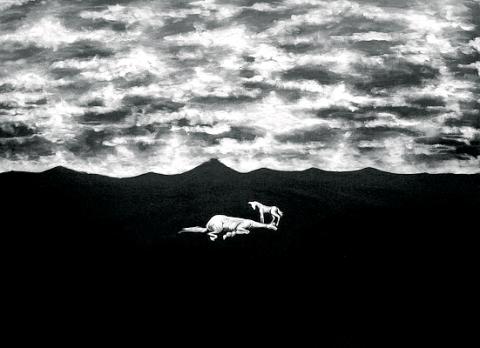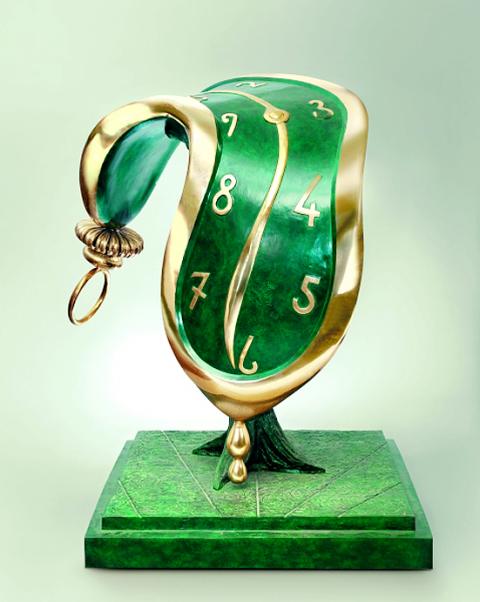Kate Chin (金質靈), who likes nothing more than to put on a leather jacket and ride a Harley Davidson, is a “liberated artist with attitude” declares the press release for her solo show at Jia Art Gallery (家畫廊). On the canvass, however, she employs her considerable talent to create works that the gallery describes as a hybrid of pop art and Chinese-style monotone ink painting, depicting horses and cows in vast, desolate landscapes to express loneliness.
■ Jia Art Gallery (家畫廊), 1F-1, 30, Zhongshan N Rd Sec 3, Taipei City (台北市中山北路三段30號1樓之1), tel: (02) 2591-4302. Open daily from 10am to 6pm
■ Opening reception on Aug. 5 at 2pm. Until Sept. 30

Photo courtesy of Jia Art Gallery
Tsao Liang-pin (曹良賓), Liao Yujun (廖逸君), Ahn Jun and Yojiro Imasaka are four contemporary photographers from, respectively, Taiwan, China, South Korea and Japan, who have come together to exhibit their work in A Vision Across Boundaries (跨渡縱目). The artists draw on their own cultural backgrounds to explore what it means to live and create in a different country – here the US – and how one makes sense of unfamiliar surroundings with the camera.
■ VT Art Salon (非常廟藝文空間), B1, 47 Yitong St, Taipei City (台北市伊通街47號B1), tel: (02) 2516-1060. Open Tuesdays through Thursdays from 1:30pm to 9pm, and Fridays and Saturdays from 1:30pm to 10pm
■ Until Saturday

Photo courtesy of IAR Art Resources
Dali: Mind of a Genius contains over 100 original works by the surrealist artist. The works on display encompass Dali’s long and prolific career, including sculptures and furniture, oil paintings and small ink sketches. The exhibition includes sections such as “Times,” a nod to his famous melting clock statues, and “Mythology,” which presents works that draw on allusions to Greek Mythology and Biblical stories.
■ Chiang Kai-shek Memorial Hall (國立中正紀念), 21-1 Zhongshan S Rd, Taipei City (台北市中山南路21-1號), tel: (02) 6630-8388. Open daily from 9am to 6pm. Admission: NT$250
■ Until Sept. 30
Artdoor Gallery is currently holding a double exhibition of calligraphy and traditional Chinese landscape painting by Chang Kuang-bin (張光賓) and Hu Ying-sheng (吳英聲).
■ Art Door Gallery (藝境畫廊), 5F, 36, Ln 164, Hulin St, Taipei City (台北市虎林街164巷36號5樓), tel: (02) 2345-6773. Open Tuesdays to Sundays from 2pm to 7pm
■ Until Aug. 5
The Power of Japanese Contemporary Sculpture is a group exhibition of sculpture by eight established contemporary artists from Japan, including Katsura Funakoshi, Katsuyo Aoki, Hiroto Kitagawa and Yoshihiro Suda. The artists work variously in wood, clay, plexiglass and paper.
■ Aki Gallery (也趣藝廊), 141 Minzu W Rd, Taipei City (台北市民族西路141號), tel: (02) 2599-1171. Open Tuesdays to Sundays from noon to 6:30pm
■ Opening reception on Aug. 5 at 3pm. Until Sept. 9

Following the shock complete failure of all the recall votes against Chinese Nationalist Party (KMT) lawmakers on July 26, pan-blue supporters and the Chinese Communist Party (CCP) were giddy with victory. A notable exception was KMT Chairman Eric Chu (朱立倫), who knew better. At a press conference on July 29, he bowed deeply in gratitude to the voters and said the recalls were “not about which party won or lost, but were a great victory for the Taiwanese voters.” The entire recall process was a disaster for both the KMT and the Democratic Progressive Party (DPP). The only bright spot for

As last month dawned, the Democratic Progressive Party (DPP) was in a good position. The recall campaigns had strong momentum, polling showed many Chinese Nationalist Party (KMT) lawmakers at risk of recall and even the KMT was bracing for losing seats while facing a tsunami of voter fraud investigations. Polling pointed to some of the recalls being a lock for victory. Though in most districts the majority was against recalling their lawmaker, among voters “definitely” planning to vote, there were double-digit margins in favor of recall in at least five districts, with three districts near or above 20 percent in

From Godzilla’s fiery atomic breath to post-apocalyptic anime and harrowing depictions of radiation sickness, the influence of the nuclear bombings of Hiroshima and Nagasaki runs deep in Japanese popular culture. In the 80 years since the World War II attacks, stories of destruction and mutation have been fused with fears around natural disasters and, more recently, the Fukushima crisis. Classic manga and anime series Astro Boy is called “Mighty Atom” in Japanese, while city-leveling explosions loom large in other titles such as Akira, Neon Genesis Evangelion and Attack on Titan. “Living through tremendous pain” and overcoming trauma is a recurrent theme in Japan’s

The great number of islands that make up the Penghu archipelago make it a fascinating place to come back and explore again and again. On your next trip to Penghu, why not get off the beaten path and explore a lesser-traveled outlying island? Jibei Island (吉貝嶼) in Baisha Township (白沙鄉) is a popular destination for its long white sand beach and water activities. However, three other permanently inhabited islands in the township put a unique spin on the traditional Penghu charm, making them great destinations for the curious tourist: Yuanbeiyu (員貝嶼), Niaoyu (鳥嶼) and Dacangyu (大倉嶼). YUANBEIYU Citou Wharf (岐頭碼頭) connects the mainland